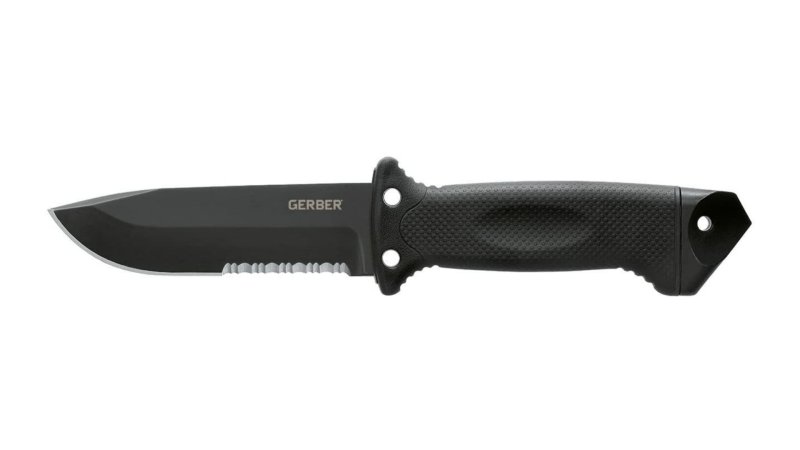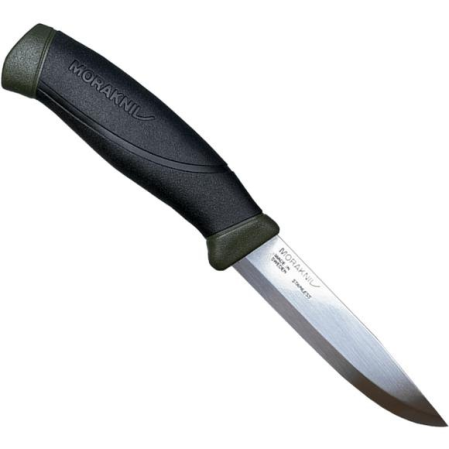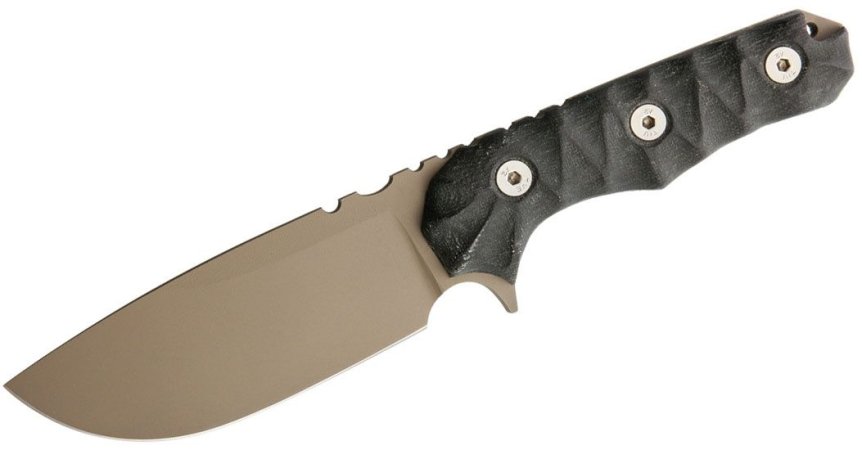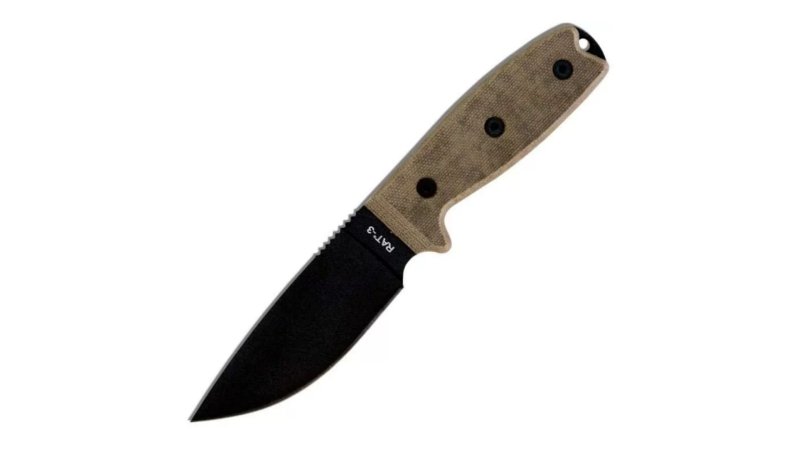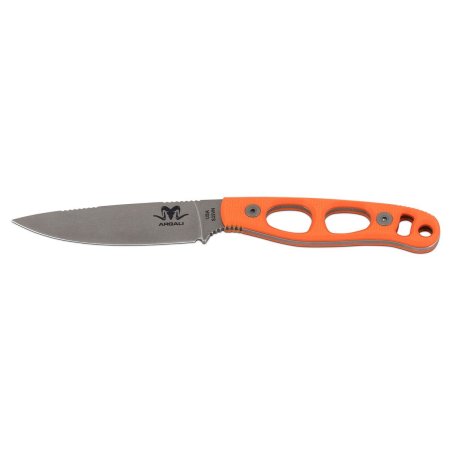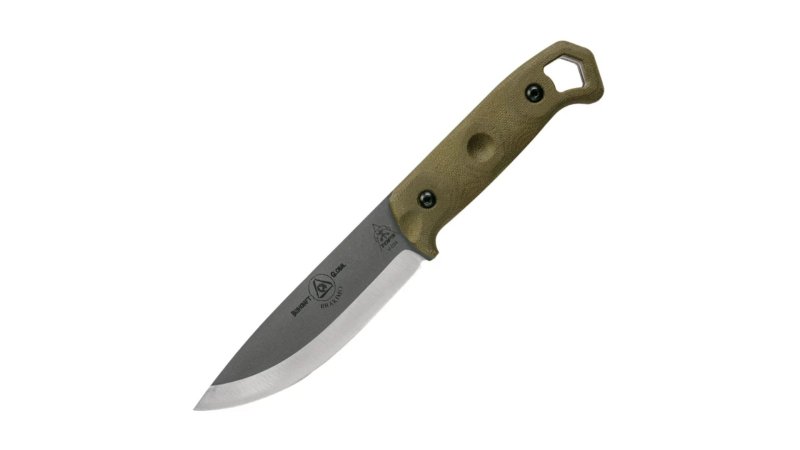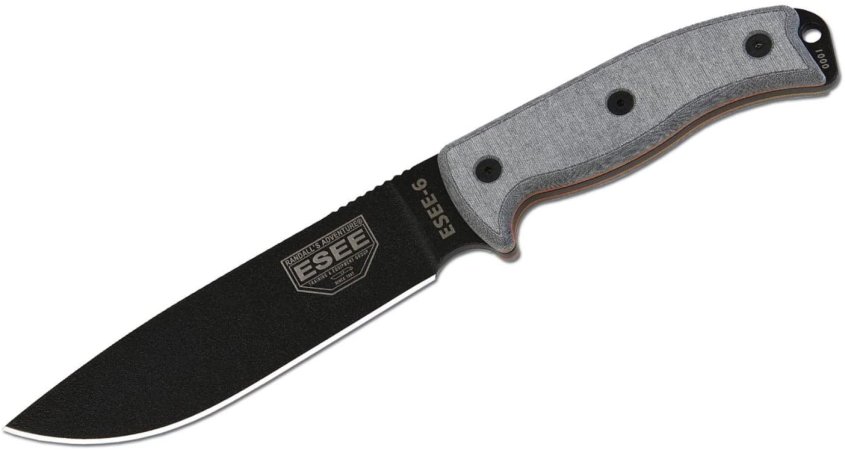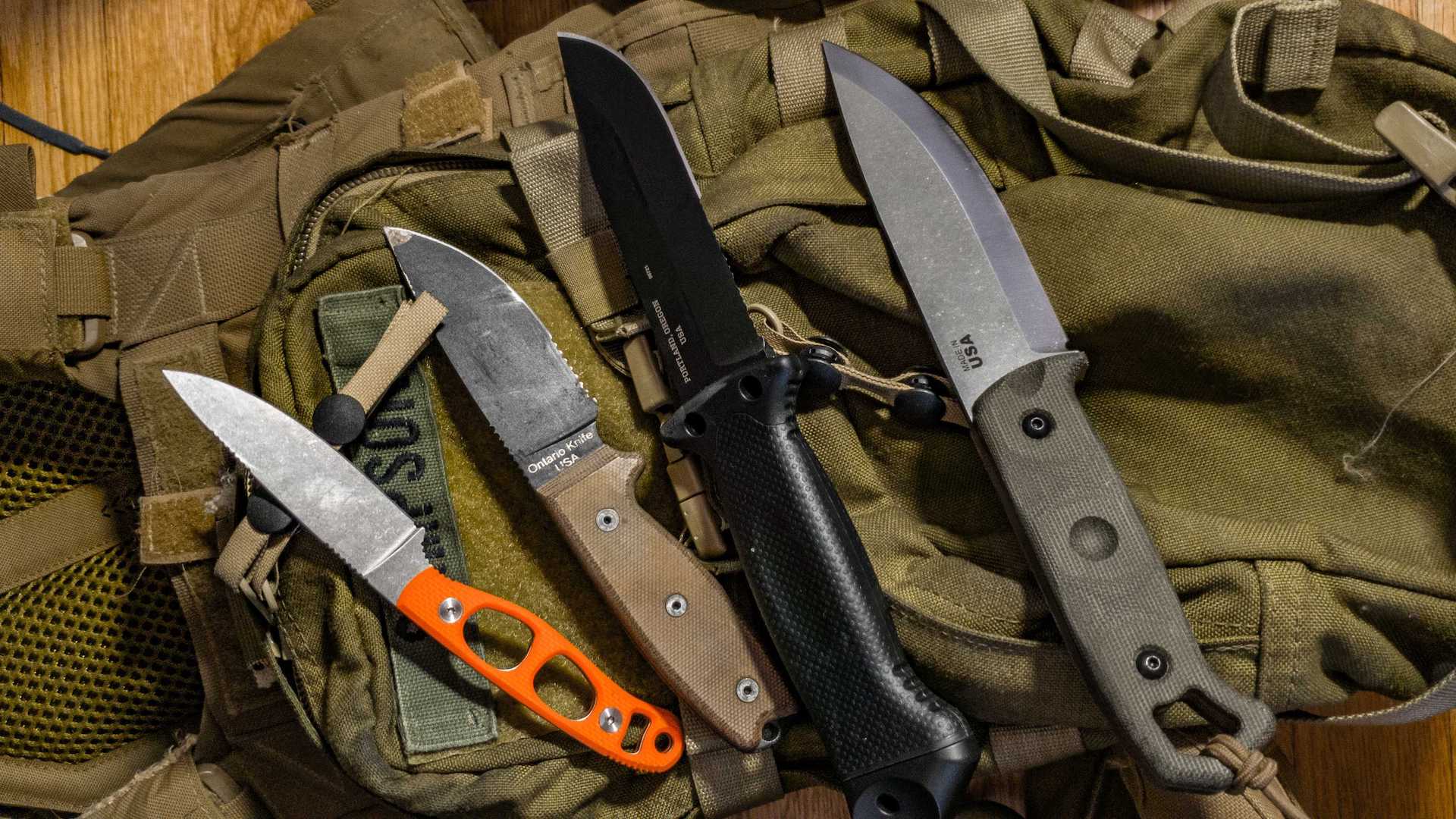

We may earn revenue from the products available on this page and participate in affiliate programs.
It can often prove difficult to nail down exactly what constitutes a survival knife. For some, a survival knife might simply mean a fixed blade that can withstand something more than pocket carry. For others, survival literally means holding onto one’s life against the torments of the wilderness as they deliberately throw themselves into the wild with nothing but a knife and maybe the clothes on their back. Since it’s impossible to state definitively that one knife will work for anyone, regardless of who they are, buying a survival knife means compiling a survey of the best ones, no matter your usage, budget, or size needs, and whittling the choices down from there. With any luck, the result will serve you well during your next outdoor adventure.
To that end, we’ve put together a list of the best survival knives that the gear reviewers here at Task & Purpose have managed to lay their hands on. Read on and find out which survival knife best fits your unique needs.
- Best Overall: Gerber LMF II Infantry Knife
- Best Value: Morakniv Companion
- Best Premium: Wander Tactical Lynx
- Best Budget American-Made: Ontario Knife Company RAT 3
- Best Hunting: Argali Carbon Knife
- Best Bushcraft: TOPS Brakimo
- Best Large: Esee 6P
Best Overall
Gerber LMF II Infantry Knife
Pros
- Versatile, with many intended purposes
- Good-quality materials
- Completely insulated from electricity
- Made in the USA
Cons
- Heavy (not very infantry, IMO)
- Rubber grip can peel away from blade and pommel
- Less durable than a full-tang knife made of similar materials
Product Specs
- Manufacturer: Gerber
- Country of manufacture: USA
- Length: 11 inches overall, 5-inch blade
- Blade steel: 420HC
- Blade profile: Drop point
- Blade grind: Saber
- Edge: Combination
- Weight: 1.3 lbs
- Stock sheath material: Molded plastic
Best Value
Morakniv Companion
Pros
- Wickedly sharp factory edge
- Reputable manufacturer
- Affordable
- Lightweight
Cons
- Not durable against blade snapping
- Cheap sheath
- Corrosion-prone
Product Specs
- Manufacturer: Morakniv AB
- Country of manufacture: Sweden
- Length: 8.6 inches overall, 4.1-inch blade
- Blade steel: UHB-20C
- Blade profile: Drop point
- Blade grind: Scandi
- Edge: Plain
- Weight: 3.9 oz
- Stock sheath material: Molded plastic
Best Premium
Wander Tactical Lynx
Pros
- Wickedly sharp factory edge
- Handmade
- Extremely durable
- Purpose-built for survival
Cons
- Poor blade coating
- Cheap sheath
- Not the most corrosion-resistant
Product Specs
- Manufacturer: Wander Tactical Research Team
- Country of manufacture: Italy
- Length: 9.25 inches overall, 4.25-inch blade
- Blade steel: D2
- Blade profile: Drop point
- Blade grind: Hollow
- Edge: Plain
- Weight: 1.2 lbs
- Stock sheath material: Kydex thermoplastic
Best Budget American-Made
Ontario Knife Company RAT 3
Pros
- Affordable
- Made in the USA
- Extremely durable
- Comfortable to use
- Easy to maintain
Cons
- Poor blade coating
- Cheap sheath
- Very prone to corrosion
- Requires constant maintenance
Product Specs
- Manufacturer: Ontario Knife Company
- Country of manufacture: USA
- Length: 7.6 inches overall, 3.6-inch blade
- Blade steel: 1075
- Blade profile: Drop point
- Blade grind: Flat
- Edge: Plain or combination
- Weight: 4.9 oz
- Stock sheath material: Nylon
Best Hunting
Argali Carbon Knife
Pros
- Made in the USA
- Extremely durable
- Outstanding edge retention
- Lightest knife on the list
Cons
- No included mounting options for the sheath
- Uncomfortable grip
- Steel is difficult to sharpen
Product Specs
- Manufacturer: Argali Outdoor
- Country of manufacture: USA
- Length: 7.25 inches overall, 3.25-inch blade
- Blade steel: CPM-S35VN
- Blade profile: Drop point
- Blade grind: Flat
- Edge: Plain
- Weight: 1.8 oz
- Stock sheath material: Kydex thermoplastic
Best Bushcraft
TOPS Brakimo
Pros
- Purebred bushcraft beast
- Made in the USA
- Extremely comfortable to use
- Extremely durable
Cons
- Scandi grind limits use for hunting or camp use
- May be too large for some users
- 1095 steel may corrode if not properly maintained
- Included belt clip is flimsy
Product Specs
- Manufacturer: TOPS Knives
- Country of manufacture: USA
- Length: 10 inches overall, 5.25-inch blade
- Blade steel: 1095
- Blade profile: Drop point
- Blade grind: Scandi
- Edge: Plain
- Weight: 9.4 oz
- Stock sheath material: Kydex thermoplastic
Best Large
Esee 6P
Pros
- Versatile in spite of size
- Made in the USA
- Comfortable to use
- Large enough to use as a machete or hatchet in a pinch
Cons
- Too long to easily carry on one’s person in most cases
- Included belt clip is cheap
- 1095 steel can corrode if not properly maintained
Product Specs
- Manufacturer: Esee
- Country of manufacture: USA
- Length: 11.75 inches overall, 6.5-inch blade
- Blade steel: 1095
- Blade profile: Drop point
- Blade grind: Flat
- Edge: Plain or combination
- Weight: 12 oz
- Stock sheath material: Molded plastic
Why you should trust us
I got into knives originally because I worked for a knife retailer that stocked a lot of the brands on this list, such as Gerber, TOPS, Ontario Knife Company, and Esee. In that time, I learned what worked and what didn’t, and saw the big issues that people would have with certain knives that caused them to bring back certain items for return or servicing. In addition to that, I’ve owned quite a few myself and have used them in various situations both as a Marine and as a civilian, and I know several knife designers and makers who have provided excellent insight for this article. I’d like to acknowledge Peter, my sharpening guy, Don Kramer of Carnivora Knives, and my West Coast counterpart, Josiah Johnston, as well as many others for providing their opinions on the knives that I chose for this article. I don’t know everything, but I know enough to know when I should ask for help, so I’ve distilled all of those insights down into a single article to make buying the best survival knives a painless experience.
Types of survival knives
There are several large categories that survival knives can be sorted into. These aren’t hard and fast, and oftentimes a knife can fit into more than one category, so take what I’m saying with a grain of salt. The types that I’ve chosen are bushcraft knives, hunting knives, fighting knives, camp knives, pack knives, and machetes. Some have been featured on this list, and most, especially the Gerber LMF II, are designed to fill multiple roles.
Bushcraft knives
Bushcraft knives are purpose-built to enable survivalists to make shelter, fire, and tools using the environment around them. To this end, they will often feature blades with a strong bevel to bite into various types of wood, a full tang to prevent snapping when the blade gets caught or when used to hack through a log, jimping and a finger choil of some sort, comfortable grips, and a thick spine to aid batoning.
Hunting knives
Hunting knives encompass a wide variety of blades, ranging from caping knives, dedicated skinning knives, boning knives, filet knives, and so on. Generally speaking, hunting knives will be designed to aid in the cleaning and dressing of game, ranging from varmint species such as rabbits to elk, bear, buffalo, and other large animals. Knives with a deeper belly are good for skinning, as they allow you to cut ahead of your knuckles, which aids in getting into hard-to-reach parts of a carcass. These knives should also be made of steel that stands up well to the corrosive effects of blood and that stays sharp for long periods of time, and feature grips that remain tactile even when slick with bodily fluids, which is a consideration for particularly greasy animals like fattened bear or javelina. Some applications such as fishing necessitate additional considerations, such as corrosion resistance.
Fighting knives
These knives are made for exactly what it says on the box: fighting. They range from the Japanese tanto blades of yore to the Sikes-Fairbairn dagger, the U.S. Marine Corps Ka-Bar, the M3, and many, many more. I didn’t include any purpose-built fighting knives on this list, as I generally find most of them to be less-than-optimal for survival use. However, any of the knives on this list will likely work in a pinch if you have to put a wallop on someone in a fight.
That being said, true fighting knives generally feature blades that are designed for their intended use, such as stabbing in the case of the M3 or Sikes-Fairbairn, slashing with the Ka-Bar, or hacking with the venerable Gurkha Kukri knife. These knives need to be weighted according to their purpose, e.g. to aid in hacking with the kukri, and need comfortable grips that aid manipulation in a high-stress, hand-to-hand environment and that mitigate shock vibration from contacting equipment, protective equipment, or bone.
Camp and pack knives
Camp and pack knives are the domestic tool of survival knives, not designed to be pulled out in a pinch to free oneself from thick vines or tangled lines, but more for building shelter, cutting food, and other tasks performed during a pause. These knives are often larger, heavier, or less durable than knives meant for more general-purpose use due to their more specialized mission. For instance, a thin camp knife such as Benchmade’s cutlery options is not suited to hacking through underbrush like a machete, but comes in handy when slicing up vegetables to prepare some Dutch oven stew. The construction of these knives will vary depending on their intended use, so what constitutes a “camp knife” is largely up to one’s judgement.
Machetes
Machetes are long knives designed specifically for hacking through vegetation, whether for trekking through the jungle or clearing one’s backyard. Due to this, they often feature front-heavy blades to aid in swinging, very forgiving blade steel to prevent chipping or breaking, and easily-resharpened edges for prolonged field usage. I didn’t feature any true machetes in this list, but certain knives like the Esee 6 are large enough to serve as a machete in some cases when it comes to stripping saplings or chopping through vines.
Key features of survival knives
Edge type
In general, edges come in three types: plain, combination, and serrated. Plain-edged knives have a straight, non-serrated blade, and offer the best slicing potential of the three. Combination edges feature a serrated portion for cutting rope, sticks, or other vegetation that would dull a plain edge more quickly. Serrated edges are fully sawtoothed and are designed for dedicated sawing tasks where a clean cut isn’t required. In general, serrations are harder to sharpen, requiring more specialized sharpening rods to get in between the teeth. However, with the proper equipment and some training, it can be just as easy as sharpening a plain edge.
Blade profile
The profile of the blade determines the blade shape, grind, and dimensions. Key terms to look for are the “point” of the blade, the “belly,” and the “grind.” The point of the blade refers to how the blade terminates when the spine meets the edge, and can mean clip point, drop point, wharncliffe, tanto, and many more. The belly of the blade refers to how deep the blade is or the distance from the spine to the edge when measured across the flat of the blade. This can affect things like usability for skinning in a hunting environment, or cutting vegetables in a camp kitchen environment. The grind of the blade refers to how the blade is beveled to the edge, and can be convex, concave, flat, Scandinavian-style, and so on. It helps to learn the types of blade profiles and see what works best for your intended application.
Jimping and choil
These are features that really help with bushcraft and hunting, allowing you to get a higher purchase on the blade for better control. Jimping refers to serrations on the spine of the knife that allow you to rest your thumb for forward pressure to push the knife through whatever you’re cutting, or angle it for whittling or skinning. Choil refers to a cutout portion of the blade ahead of the grip but behind the cutting edge, which in conjunction with jimping, can greatly increase your control of the blade.
Steel
The steel used in the blade is probably the biggest factor that determines price to the end-user. Steels like AUS-8, 440C, and 8Cr12MoV are cheaper to manufacture, and more forgiving to heat-treat, and while they can be very capable when used by a capable designer who knows what they’re good for and properly heat-treated by a good knifemaker, in general more exotic steels like S35VN, S30, 90, 110, and 120V, as well as things like Elmax are going to have better performance, in exchange for a much higher price tag. Knives made with good steel, a good heat-treat, and designed in small batches by a boutique shop are going to be more expensive still.
Tang
Knives with full tangs are going to generally be more durable, at the expense of requiring more steel to manufacture. On knives made of more expensive steels, this means that the grip is the same steel as the blade, treated and coated the same. Knives with hidden tangs, spoon tangs, partial tangs, and so forth, save on cost and weight, at the expense of durability.
Manufacturer
Quality control, country of manufacture, and whether or not the knife is mass-produced all factor into the cost. A knife that’s sharp, durable, and well-finished every time will, by necessity, cost more than a knife that’s haphazardly thrown together with an uneven blade grind. Knives made in countries with better labor rights for their workers will also generally be more expensive than those made in sweatshops, which requires you to see if you value ethics over the impact to your pocketbook. Additionally, a knife that’s handmade by an artisan is going to cost more than a knife made in a factory that has assembly lines dedicated to producing that knife and that knife only.
Pricing considerations of survival knives
Less than $75
At the low end of survival knives, you can expect to find basic features, materials, and production, and if you’re not careful, terrible quality control. In general, knives at this price point will feature cost-cutting measures such as inexpensive blade steels, small hidden tangs, less precise heat treatment, and overall a generally less-precise design. What you can still get is a capable knife that will stand up to usage if you know where to look, and that’s what we aimed to address with our budget options.
$75-$300
The medium range for survival knives is where most people will have the most success, putting you squarely in the zone of great returns on investment. Here you’ll start to see premium materials, good quality control, and designs by some of the best minds in the knifemaking game. All of the knives reviewed today fit into this category, mostly because this is the area in which most people are comfortable spending the required money and still actually using the knife for harsh utility purposes.
More than $300
Above the $300 price point is when you start to get into knives that feature unusual opening mechanisms, exotic materials, or boutique production. Hand-made small batch knives like those from Half Face Blades, Toor, Chris Reeve and Marfione Customs live around this level, and you can expect knives that have an incredible level of finishing, care in their production, and quality control. However, you’ll also find knives that have an inflated cost due to brand deals or cachet, so make sure you’re buying the features you want and not just the name.
How we chose our top picks
All of these knives were tested through hands-on use in their intended roles — and then some. I’m a firm believer that you can’t know how good something is until you’ve held it, used it, and seen where it fails you. These knives were selected using the criteria of availability, cost-effectiveness, usability, and reputation. I’m not going to recommend some obscure hipster knife that takes months of waiting to get, and at the same time I’m not going to recommend knives that are expensive for no reason, knives that are minimally practical, or knives that are from companies known for producing as many lemons as they do decent knives (looking at you, SOG.) Obviously, I couldn’t cover every option, and you should feel free to let me know if you have a favorite that works for you.
FAQs about survival knives
You’ve got questions, Task & Purpose has answers.
Q. What is the best survival knife?
A: Our pick for the best overall survival knife is the Gerber LMF II, which is not to say that it’s the absolute best at anything, just that it’s a knife that will work well for most people’s purposes. Personally, I like the TOPS Brakimo, but that’s what works for my intended purposes.
Q. Is it legal to carry a survival knife?
A: That depends on your locality. Certain states prohibit the concealed carry of fixed blade knives, or knives over certain lengths. In general, these are knives intended for use in the wilderness, and most places in the world have exceptions in their knife laws for “good reason,” which is usually satisfied by being on a hiking or camping trip. As always, know your local laws.
Q. What are the holes on a survival knife for?
A: Holes on a survival knife can serve many purposes, ranging from being lightening cuts, as with the Argali Carbon, to lashing holes on the Gerber LMF II that allow you to make an improvised spear, to lanyard loops to allow one to retain the knife easier in highly mobile situations like rock climbing or on a boat. Other uses can be for using a hand drill to make fire, straightening arrowheads, or opening gas keys on an oxygen tank.
Q. How thick should a survival knife be?
A: Generally speaking, knives that are 4mm in thickness or greater at the spine are going to be able to stand up to the kind of high-impact use that’s required to strip branches, baton logs, and chop wood. However, this is not a hard and fast rule, and the thickness can also be dependent on factors such as blade length, intended use, and blade steel. Making the blade too thick can add unnecessary weight or make the knife minimally useful for cleaning animals or cutting vegetables.
Q. What is jimping?
A: Jimping is the name for serrations on the spine of the knife, which allow you to get greater control of the knife when performing delicate tasks such as whittling or cleaning an animal. They allow you to get a grip on the spine of the blade with your thumb.
Q. What is the best type of steel for a knife’s blade?
A: This depends on your intended usage, your sharpening capabilities, and your budget. I personally prefer CPM S35VN, as it holds an edge for a very long time and keeps rust off very well. However, it’s difficult to resharpen and requires that I send it off to a professional for resharpening. Many survival knife companies seem to prefer 1095, 420HC, and D2, as they’re easy enough to resharpen and offer good edge retention, at the expense of corrosion resistance. Buyers looking for knives to use around water, especially saltwater, should look for knives specifically designed to hold up against heavy corrosion.
Q. How can I sharpen my knife?
A: We did a great article on this, but in general you should invest in a good-quality guided sharpener for home usage, and a good-quality portable sharpening stone for use in the field, and learn how to use both properly. This will enhance the service life of your knife and save you money in the long run that would be otherwise spent on sending your knife to a professional for sharpening.
